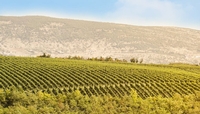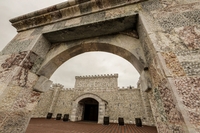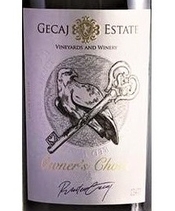Kosovo became an independent country when its parliament declared independence from Serbia on February 17, 2008. This political green light triggered the eventual fulfillment of a host of political opportunities, including the approval of a constitution, which had been waiting for this historic moment.

Independence also signaled that the time had come to begin seriously upgrading the local wine industry. The region that is now Kosovo has been cultivating grapes and producing wine for two thousand years, but the breakup of Yugoslavia and the conflicts of the 1990s seriously damaged not only the vineyards and wineries, but also impaired the forward momentum that every serious wine region needs in order to be successful. Numbers of estates were abandoned and/or destroyed during the chaos, but progress is now being made to bring some of them back as well as to establish new estates.
Today’s Kosovo is divided into 18 distinct wine regions, with the bulk of the production in Rahovec Valley. Given its mostly clay and limestone soils and elevations up to 1,700 feet above sea level it is hardly surprising that Rahovec is considered Kosovo’s premier wine growing region. The climate here tends to be moderate, averaging approximately 270 days of sunshine. Covering about 10,000 hectares, Rahovec vineyards are dominated by red wine grapes spreading across 49% of the vinous territory.
White varieties occupy some 26% of the viticultural acreage, with table grapes claiming the rest. Interestingly, red wine grapes are currently divided almost evenly between foreign varieties (Pinot Noir, Merlot, Cabernet Sauvignon and so on) with the other half given over to Balkan varieties such as Prokupa, Zhameta and, especially, Vranac. Among white wine grapes Riesling, along with Smederevka--a sweet Balkan grape that is high in both natural sugars and acidity that is widely planted in Serbia and Hungary as well as Kosovo--are becoming increasingly popular across the region. Today Kosovo claims 32 registered wineries.
Yugoslavian-born Rrustem Gecaj left his war-torn country in the 1970s. After brief stints in Italy and Canada he settled in New York City. He became a U.S. citizen. He worked in a variety of restaurants. He owned a pizzeria.

Eventually Gecaj transitioned into real estate, building a portfolio of commercial and residential properties. In 2006, with the war in Yugoslavia over and many businesses there becoming privatized, Gecaj returned to Kosovo and purchased NBI Rahoveci, a winery that had been built by the Yugoslavian government in1953. Renaming the estate “Stone Castle”, and with the help of family members including his sons Avni and Avdi, Gecaj set about modernizing the winery and revitalizing the vineyard.
The property Gecaj had purchased in 2006 was in terrible condition, neglected and uncultivated, including its 250-hectare vineyard. Today Stone Castle is the largest winery in Kosovo. It boasts some 500 hectares of well-tended vines, and older vineyards are being upgraded. Two hundred and fifty vineyard workers are employed full time, and there are about 700 part-time seasonal workers. With the ultimate goal of becoming entirely self-sustaining, current upgrades at Stone Castle include an energy-saving gravity flow system. Some of the vineyards are being farmed organically, and the ultimate goal is to convert the entire estate to organic practices.
As a symbol of their commitment to Kosovo’s rich heritage and ongoing resilience the Gecaj family modeled the entrance to Stone Castle after the historic
kulla structures that are indigenous to the Balkan region. Three to four stories high and resembling miniature fortresses, kullas are distinctive square or rectangular thick-walled stone towers that were built by both Muslim and Christian communities between the 17th and 20th centuries to serve as either military structures or dwellings, or both.
Wine tourism has become a reality in Kosovo, with wine routes popping up across the region. For a preview of the wines you might taste if you visit Kosovo, try some of the excellent Stone Castle wines that are currently imported to the US.
Stone Castle, Rahovec Valley (Kosovo) Shiraz 2018 ($18, Stone Castle Imports, Bronx, NY): Stone Castle Shiraz is relatively well-behaved compared to some of the currently popular rowdy, high-alcohol examples of Shiraz/Syrah. It offers a purple-ruby color and pleasing aromas that include dark berries plus a light touch of spice, notably cardamom and cinnamon. On the palate, the medium-weight wine presents a complex mélange of blueberries and blackberries along with touches of anise, black olives, and a hint of chocolate. To my palate it is stylistically more like a subtle French Rhône Valley Syrah than a powerful Australian Shiraz.
93
Stone Castle, Rahovec Valley (Kosovo) Chardonnay 2018 ($24): With tropical fruits leading the aromatic lineup, Stone Castle’s Chardonnay is lean and refreshing. A delicate floral presence, along with nuances of pineapple and citrus are part of the wine’s charm, but what I found most interesting here is the presence of minerality. This minerality was notable in the wine’s aroma and lingered all the way through the finish, with no pesky vanilla or oak presence getting in the way. Gastronomically speaking, this is a Chardonnay that brings out the best in simple foods, from a tuna & tomato sandwich to a filet of sole sautéed in lots of butter, to pan roasted brussel sprouts.
93
Stone Castle, Rahovec Valley (Kosovo) Cabernet Sauvignon Reserve, Nashpall Vineyard 2017 ($24): A stunningly successful Cabernet made from grapes grown in a high elevation vineyard, this Cabernet offers succulent notes of blackberry and raspberry fruit gracefully balanced by subtle oak (the wine was aged 12 months in French oak). The well integrated alcohol level (13.8) is less than one might suspect given this Cabernet’s power. I would bet this is a Cab that, if kept in excellent conditions, might age beautifully for another few years.
94
Stone Castle, Rahovec Valley (Kosovo) Merlot, Fushe-Zoqisht Vineyard 2018 ($16): From hand-harvested grapes grown in a high altitude vineyard with constant sun exposure, this balanced and elegant Merlot was fermented 16 days in closed stainless steel containers, then aged 16 months in oak barrels. It offers complexity and good length.
94
Stone Castle, Rahovec Valley (Kosovo) Gjergj Kastrioti, “Ancient Vranç”, Lisdrvish Vineyard 2018 ($16): Vranc (sometimes written “Vranac”) is a grape indigenous to the Balkan region. If Stone Castle’s version is typical of what the Vranc grape can offer, I say, “Bring on more!” Neither in its aromas or flavors does this wine seem particularly exotic or unfamiliar. On the contrary, it‘s simply an, approachable, tasty and fairly complex red wine. Darkly colored, medium bodied, and with a round, somewhat silky, texture it is pleasantly fruity and balanced by just the right mount of acidity. The wine’s name is a tribute to Gjergi Kastrioti, a 15th century Albanian feudal lord who led a rebellion against the Ottoman Empire.
94
 Stone Castle, Gecaj Estate, Rahovec Valley (Kosovo) Izbishte Vineyard “Owner's Choice” 2017
Stone Castle, Gecaj Estate, Rahovec Valley (Kosovo) Izbishte Vineyard “Owner's Choice” 2017 ($80): Knowing beforehand that this wine was aged in new American and Hungarian oak, I worried that the wine might be too oaky. Knowing that the vineyard had sat under the summer sun for 10-12 hours a day, my concern was that the wine’s flavors might skew too far in the direction of overripe sweet fruit, and perhaps too much alcohol. Happily, all these concerns vanished the moment I tasted the wine. The oak played its role as supporting actor perfectly, adding subtle heft to the wine’s overall flavor, texture and complexity. The fruit flavors themselves were fresh and intricate, and the alcohol was unobtrusive. As an aside, the design of the label on “Owner’s Choice" -- featuring a drawing of an eagle holding (presenting?) a key -- was singularly eye-catching, as are many Stone Castle labels.
96
Photos Courtesy of Stone Castle Vineyards And Winery www.StoneCastleWine.com